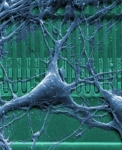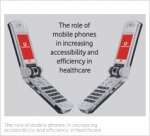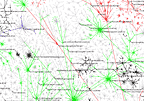Mar 28, 2006
Robust classification of EEG signal for brain-computer interface
Robust classification of EEG signal for brain-computer interface.
IEEE Trans Neural Syst Rehabil Eng. 2006 Mar;14(1):24-9
Authors: Thulasidas M, Guan C, Wu J
We report the implementation of a text input application (speller) based on the P300 event related potential. We obtain high accuracies by using an SVM classifier and a novel feature. These techniques enable us to maintain fast performance without sacrificing the accuracy, thus making the speller usable in an online mode. In order to further improve the usability, we perform various studies on the data with a view to minimizing the training time required. We present data collected from nine healthy subjects, along with the high accuracies (of the order of 95% or more) measured online. We show that the training time can be further reduced by a factor of two from its current value of about 20 min. High accuracy, fast learning, and online performance make this P300 speller a potential communication tool for severely disabled individuals, who have lost all other means of communication and are otherwise cut off from the world, provided their disability does not interfere with the performance of the speller.
23:16 Posted in Brain-computer interface | Permalink | Comments (0) | Tags: Positive Technology
Attention rehabilitation following stroke and traumatic brain injury
Attention rehabilitation following stroke and traumatic brain injury. A review.
Eura Medicophys. 2006 Mar;42(1):59-67
Authors: Michel JA, Mateer CA
Attentional capacities, which are frequently impaired following brain injury, have also been found to be amenable to rehabilitation. This review discusses various approaches to attention rehabilitation in adult clients following stroke and traumatic brain injury. Attention process training has been accepted by many as a practice standard in postacute clients, however, its ability to generalize to new situations and to functional capacities is unclear. There is evidence for the use of psychostimulant medication, which may be most helpful when prescribed in combination with attention training. Biofeedback is a new avenue for intervention and is beginning to show some promising RESULTS: Rather than train underlying processes, another approach which shows promising results in a few small studies is training clients on specific functional skills, such as driving or vocational duties. Finally, modifications to the environment, implementation of strategies, provision of emotional support, and introduction of external supports/aids are important parts of a rehabilitation program, especially as the client returns to their home environment.
23:14 Posted in Biofeedback & neurofeedback | Permalink | Comments (0) | Tags: Positive Technology
gizmag: New Computer Interface Provides a Mental Typewriter and Brain Pong
The initial project demonstrates how a paralyzed patient could communicate by using a mental typewriter alone - without touching the keyboard. In the case of serious accident or illness, a patient’s limbs can be paralyzed, severely restricting communication with the outside world.
23:05 Posted in Brain-computer interface | Permalink | Comments (0) | Tags: Positive Technology
Mar 27, 2006
Avatar-mediated personality
Via New Scientist
When people take on a virtual computer-persona, the look of their character, or avatar, has a profound effect on their behaviour, according to Nick Yee and Jeremy Bailenson of Stanford University in Palo Alto, California:
Are you a confident, square-jawed warrior or a height-conscious little goblin? If you ever take on a virtual computer persona, the look you opt for may have a profound effect on your behaviour.
Online, in virtual worlds and chat rooms where people create cartoons of themselves known as avatars, changing your image is as simple as making a few clicks of a mouse. As people alter the appearance of their avatars, does their behaviour unwittingly change too?
To answer this question, Nick Yee and Jeremy Bailenson of Stanford University in Palo Alto, California, assigned two groups of students an avatar each, using a virtual reality headset. They were given less than a minute to examine their new selves in a "mirror" before being asked to step into a virtual room with another avatar controlled by an independent helper.
Irrespective of their real-life height, some in the first group were assigned ...
Read the full article
21:12 Posted in Telepresence & virtual presence | Permalink | Comments (0) | Tags: Positive Technology
Medgadget: Neuro Semi-Conductor Interface
Via Medgadget

According to Information Society Technologies (IST), European investigators have created a novel interface between mammalian neurons and silicon chips. The development, achieved by the NACHIP project, funded by the EU Commission's Future and Emerging Technologies, is a "crucial first step in the development of advanced technologies that combine silicon circuits with a mammal's nervous system. "
From the press release:
The ultimate applications are potentially limitless. In the long term it will possibly enable the creation of very sophisticated neural prostheses to combat neurological disorders. What's more, it could allow the creation of organic computers that use living neurons as their CPU.Those applications are potentially decades away, but in the much nearer term the new technology could enable very advanced and sophisticated drug screening systems for the pharmaceutical industry.
"Pharmaceutical companies could use the chip to test the effect of drugs on neurons, to quickly discover promising avenues of research," says Professor Stefano Vassanelli, a molecular biologist with the University of Padua in Italy, and one of the partners in the NACHIP project, funded under the European Commission's Future and Emerging Technologies initiative of the IST programme.
NACHIP's core achievement was to develop a working interface between the living tissue of individual neurons and the inorganic compounds of silicon chips. It was a difficult task.
"We had a lot of problems to overcome," says Vassanelli. "And we attacked the problems using two major strategies, through the semiconductor technology and the biology."
21:08 Posted in Neurotechnology & neuroinformatics | Permalink | Comments (0) | Tags: Positive Technology
Mantra Mouse
From Medgadget
There is a small, hand-held and self contained GSR2 which has sold a half a million units and is already the largest selling Galvanic Skin Response monitoring device for home biofeedback. The GSR2 precisely monitors your stress levels by translating tiny tension-related changes in skin pores into a rising or falling tone. By resting two fingers on the sensing plates you learn to lower the pitch and your stress level.
21:04 Posted in Biofeedback & neurofeedback | Permalink | Comments (0) | Tags: Positive Technology
Wired: brain-training game
Can a new generation of mind-training games actually make you smarter?
Commentary by Clive Thompson (Wired)
A while ago, the science writer Steven Johnson was looking at an old IQ test known as the "Raven Progressive Matrices." Developed in the 1930s, it shows you a set of geometric shapes and challenges you to figure out the next one in the series. It's supposed to determine your ability to do abstract reasoning, but as Johnson looked at the little cubic Raven figures, he was struck by something: They looked like Tetris.
A light bulb went off. If Tetris looked precisely like an IQ test, then maybe playing Tetris would help you do better at intelligence tests. Johnson spun this conceit into his brilliant book of last year, Everything Bad Is Good For You, in which he argued that video games actually make gamers smarter. With their byzantine key commands, obtuse rule-sets and dynamic simulations of everything from water physics to social networks, Johnson argued, video games require so much cognitive activity that they turn us into Baby Einsteins -- not dull robots.
I loved the book, but it made me wonder: If games can inadvertently train your brain, why doesn't someone make a game that does so intentionally?
I should have patented the idea. Next month, Nintendo is releasing Brain Age, a DS game based on the research of the Japanese neuroscientist Ryuta Kawashima.
Read the full article
18:19 Posted in Brain training & cognitive enhancement | Permalink | Comments (0) | Tags: Positive Technology
Mar 26, 2006
Tango!
Via Engadget
 A company named AbleNet is busting out an interesting new handheld device called Tango! which does the "AAC" thing (Augmentative and Alternative Communication - new one on us) to help kids learn English, or for those that are hearing or speech impaired, allowing for the easy creation of sentences. You can use predetermined phrases by punching through a few sub-categories, or make your own with the device's intuitive interface. The Tango! also allows the creation of your own items; the built-in camera can capture a new image to serve as an icon, and then an adult can record the correct phrase for the item, even with a simulated child's voice. The device can expand its functionality via USB, CompactFlash, and SD, with the option to use a keyboard, or even work over a cellphone down the line. Sadly the unit runs for a steep $6899, but hopefully AbleNet can get some quantity orders in and cut that down a bit.
A company named AbleNet is busting out an interesting new handheld device called Tango! which does the "AAC" thing (Augmentative and Alternative Communication - new one on us) to help kids learn English, or for those that are hearing or speech impaired, allowing for the easy creation of sentences. You can use predetermined phrases by punching through a few sub-categories, or make your own with the device's intuitive interface. The Tango! also allows the creation of your own items; the built-in camera can capture a new image to serve as an icon, and then an adult can record the correct phrase for the item, even with a simulated child's voice. The device can expand its functionality via USB, CompactFlash, and SD, with the option to use a keyboard, or even work over a cellphone down the line. Sadly the unit runs for a steep $6899, but hopefully AbleNet can get some quantity orders in and cut that down a bit.
20:40 Posted in Brain training & cognitive enhancement | Permalink | Comments (0) | Tags: Positive Technology
Textually: Mobile phones in healthcare

In a lengthy and thorough article entitled Mobile phones and health, The Economist, reports on a study carried out by Rifat Atun and his colleagues at Imperial College, London, rounding up 150 examples of the use of text-messaging in the delivery of health care. "These uses fall into three categories: efficiency gains; public-health gains; and direct benefits to patients by incorporating text-messaging nto treatment regimes. The study, funded by Vodafone.
20:26 Posted in Wearable & mobile | Permalink | Comments (0) | Tags: Positive Technology
Textually: Small screens a contributing factor to visual fatigue
 Studies have found that the majority of people who work at a computer experience some eye or vision problems, and that the level of discomfort appears to increase with the amount of computer use, reports medical news today . "But, increased use of smaller, portable work and recreational gadgets such as PDAs, laptops and cell phones may also be contributing factors to the visual fatigue and discomfort experienced by millions, according to leading expert, Dr. Jeffrey Anshel."
Studies have found that the majority of people who work at a computer experience some eye or vision problems, and that the level of discomfort appears to increase with the amount of computer use, reports medical news today . "But, increased use of smaller, portable work and recreational gadgets such as PDAs, laptops and cell phones may also be contributing factors to the visual fatigue and discomfort experienced by millions, according to leading expert, Dr. Jeffrey Anshel."20:23 Posted in Wearable & mobile | Permalink | Comments (0) | Tags: Positive Technology
Smart Mobs: Bioengineering professor hopes to mimic the brain on a chip
Kwabena Boahen, an associate professor in the Department of Bioengineering, leads a research group that is trying to mimic the functions of the brain’s complex neural system using silicon chips.

Read the Stanford's report
20:19 Posted in Neurotechnology & neuroinformatics | Permalink | Comments (0) | Tags: Positive Technology
CIO: Visualization of Internet Ownership



From CIO: What is this ball of colors? It is the North American Internet, or more specifically a map of just about every router on the North American backbone, (there are 134,855 of them for those who are counting). The colors represent who each router is registered to. Red is Verizon; blue AT&T; yellow Qwest; green is major backbone players like Level 3 and Sprint Nextel; black is the entire cable industry put together; and gray is everyone else, from small telecommunications companies to large international players who only have a small presence in the U.S. If you click on the map it will take you to much bigger version complete with labels that tell you the address of many of the routers
20:13 Posted in Information visualization | Permalink | Comments (0) | Tags: Positive Technology
Mar 25, 2006
The current state of VR
Though the current state of VR technology is ahead of what has been brought to the consumer market thus far, compelling applications still need to be developed - ones that really open up new services and information sources almost as much as the Web has already done," said Jackie Fenn at Gartner.
Virtual Reality had a genuine buzz going for it about 10 years ago, when movies like The Lawnmower Man and Virtuosity were getting the green light, and Nintendo's Virtual Boy game system attempted to bring the so-called artificial world into everyday living. The possibility of complete immersion in a computer-generated environment seemed, for a time, to fire up the public's imagination...
20:05 Posted in Virtual worlds | Permalink | Comments (0) | Tags: Positive Technology
Virtual reality exposure in the treatment of arachnophobia
Effectiveness of virtual reality exposure in the treatment of arachnophobia using 3D games.
Technol Health Care. 2006;14(1):19-27
Authors: Bouchard S, Côté S, St-Jacques J, Robillard G, Renaud P
Buying or creating a virtual reality (VR) software is very costly. A less expensive alternative could be to modify already existing 3D computer games. The goal of this study is to assess the effectiveness of in virtuo exposure in the treatment of arachnophobia using modified 3D games. Participants were 10 women and 1 man. Virtual worlds were created using the game editor of a 3D computer game (Half-Lifetrade mark), modified to offer graduals hierarchies of fearful stimuli (spiders). Analyses revealed significant improvement between pre and post results on the behavioral avoidance test, the Spider Beliefs Questionnaire, and perceived self-efficacy. These promising results suggest that therapy using virtual reality exposure via a modified computer game is useful in the treatment of arachnophobia.
18:00 Posted in Cybertherapy | Permalink | Comments (0) | Tags: Positive Technology
Mar 24, 2006
Senior and Junior Researcher Positions available in the NeuroVers-IT project
In the framework of the European Union’s Marie Curie network for human resources and mobility activity, a new project “NeuroVers-IT” investigating Neuro-Cognitive Science and Information Technology has been set up. The project aims at collaborative, highly multidisciplinary research between 11 European well-known research institutions in the areas of neuro-/cognitive sciences/biophysics and robotics/information technologies/ mathematics. Topics covered are self-learning and self-configuring systems, bi-directional neuro-electronic interfaces (microelectronics devices and systems interfacing neuronal cultures to computers) and integrating methods of self-learning, task orientation and adaptation into “living” artefacts (robot systems controlled by real neural networks). For this project, all research institutions participating in the project are looking for European experienced PdD researcher or early stage researcher.
The ideal candidates should have a university degree in neuroscience, a cognitive science, computer science/mathematics and/or electrical engineering/biophysics. A good knowledge of spoken and written English is required along with a disposition to work in different European countries while being employed at one of the partner institutions. Both types of positions involve extensive personal career plans and training at the “home” institution of the researcher and at the partner labs, participation in organizing a Neuro-Engineering summer school and e-learning platform facilities.
For information about these positions you may contact
Prof. Dr. Alois Knoll, Technische
Universität München, Fakultät für Informatik, E-mail neuroversit@in.tum.de,
Tel. +49 89 289 18106.
You may also send your written application including your CV and other relevant material to vehne@in.tum.de before Apr. 20, 2006. Your application will then be forwarded to one of the research institutions of the project.
15:05 Posted in Research institutions & funding opportunities | Permalink | Comments (0) | Tags: Positive Technology
Mar 23, 2006
Virtual reality machine gives police hallucinations
From Desmoinesregister
Tom Alex
 Des Moines Police Officer Paul Tieszen stepped onto a city bus and into a world he's only heard about.
Des Moines Police Officer Paul Tieszen stepped onto a city bus and into a world he's only heard about.
"Things flash out of nowhere. Small voices saying, 'Go get your medication.' The bus driver is talking to you normally and all of a sudden he starts calling you 'Your Highness.' Then he becomes part of the hallucination," says Tieszen. "It's a whole busload of children, then it changes to a busload of adults. There's a nurse involved. You see normal things and then all of a sudden someone pulls up next to you and says, 'Get off the bus.' "
The bus wasn't real, but the officer's reactions were. And he quickly got a glimpse of what it's like to suffer from a severe mental illness.
Tieszen's window into the world of hallucinations was provided by a high-tech virtual reality mask that police use to better understand the mentally ill people they come in contact with.
"You are in the role of the individual on the bus," he said, trying to describe the experience. "You are seeing what is in the mind of someone who is like that."
The device is called a virtual hallucination machine. It was introduced to police by Teresa Bomhoff, president of the National Alliance for the Mentally Ill of Greater Des Moines....
Read the full article
20:45 Posted in Virtual worlds | Permalink | Comments (0) | Tags: Positive Technology
Functional Magnetic Resonance Imaging Investigation of the Effects of Neurofeedback Training on Children
Functional Magnetic Resonance Imaging Investigation of the Effects of Neurofeedback Training on the Neural Bases of Selective Attention and Response Inhibition in Children with Attention-Deficit/Hyperactivity Disorder.
Appl Psychophysiol Biofeedback. 2006 Mar 22;
Authors: Beauregard M, Lévesque J
Two functional magnetic resonance imaging (fMRI) experiments were undertaken to measure the effect of neurofeedback training (NFT), in AD/HD children, on the neural substrates of selective attention and response inhibition. Twenty unmedicated AD/HD children participated to these experiments. Fifteen children were randomly assigned to the Experimental (EXP) group whereas the other five children were randomly assigned to the Control (CON) group. Only subjects in the EXP group underwent NFT. EXP subjects were trained to enhance the amplitude of the SMR (12-15 Hz) and beta 1 activity (15-18 Hz), and decrease the amplitude of theta activity (4-7 Hz). Subjects from both groups were scanned one week before the beginning of NFT (Time 1) and 1 week after the end of NFT (Time 2), while they performed a "Counting Stroop" task (Experiment 1) and a Go/No-Go task (Experiment 2). At Time 1, in both groups, the Counting Stroop task was associated with significant activation in the left superior parietal lobule. For the Go/No-Go task, no significant activity was detected in the EXP and CON groups. At Time 2, in both groups, the Counting Stroop task was associated with significant activation of the left superior parietal lobule. This time, however, there were significant loci of activation, in the EXP group, in the right ACC, left caudate nucleus, and left substantia nigra. No such activation loci were seen in CON subjects. For the Go/No-Go task, significant loci of activation were noted, in the EXP group, in the right ventrolateral prefrontal cortex, right ACcd, left thalamus, left caudate nucleus, and left substantia nigra. No significant activation of these brain regions was measured in CON subjects. These results suggest that NFT has the capacity to functionally normalize the brain systems mediating selective attention and response inhibition in AD/HD children.
18:26 Posted in Biofeedback & neurofeedback | Permalink | Comments (0) | Tags: Positive Technology
Mar 22, 2006
Advanced Course in Computational Neuroscience
August 7th – September 1st 2006, ARCACHON, FRANCE
The Advanced Course in Computational Neuroscience is for advanced graduate students and postdoctoral fellows who are interested in learning the essentials of the field.
We seek students of any nationality from a variety of disciplines, including neuroscience, physics, electrical engineering, computer science, mathematics and psychology. Students are expected to have a keen interest and basic background in neurobiology as well as some computer experience.
The course has two complementary parts. Mornings are devoted to lectures given by distinguished international faculty on topics across the breadth of experimental and computational neuroscience. During the rest of the day, students are given practical training in the art and practice of neural modelling, largely through the medium of their
individual choice of model systems.
The first week of the course introduces students to essential neurobiological concepts and to the most important techniques in modelling single cells, networks and neural systems. Students learn how to solve their research problems using software packages such as MATLAB, NEST, NEURON, XPP, etc. During the following three weeks the lectures cover specific brain areas and functions. Topics range from modelling single cells and subcellular processes through the simulation of simple circuits, large neuronal networks and system level models of the brain.
Applications, including a description of the target project must be submitted electronically (see below) and should be accompanied by the names and email details of two referees who have agreed to furnish references. Applications will be assessed by a committee, with selection being based on the following criteria: the scientific quality of the candidate (CV) and of the project, the recommendation letters, and evidence that the course affords substantial benefit to the candidate's training.
More information and application forms can be obtained from:
19:56 Posted in Neurotechnology & neuroinformatics | Permalink | Comments (0) | Tags: Positive Technology
Mar 21, 2006
Time Magazine: how digital juggling is affecting kids' brains
Via Smart Mobs
Time Magazine's cover story this week is on kids' multitasking skills and what all that digital juggling is doing to their brains and family life.
 There is no doubt that the phenomenon has reached a kind of warp speed in the era of Web-enabled computers, when it has become routine to conduct six IM conversations, watch American Idol on TV and Google the names of last season's finalists all at once.
There is no doubt that the phenomenon has reached a kind of warp speed in the era of Web-enabled computers, when it has become routine to conduct six IM conversations, watch American Idol on TV and Google the names of last season's finalists all at once.
... Although multitasking kids may be better prepared in some ways for today's frenzied workplace, many cognitive scientists are positively alarmed by the trend. "Kids that are instant messaging while doing homework, playing games online and watching TV, I predict, aren't going to do well in the long run," says Jordan Grafman, chief of the cognitive neuroscience section at the National Institute of Neurological Disorders and Stroke. On the positive side, Gen M students tend to be extraordinarily good at finding and manipulating information. And presumably because modern childhood tilts toward visual rather than print media, they are especially skilled at analyzing visual data and images, observes Claudia Koonz, professor of history at Duke University.
11:02 Posted in Persuasive technology | Permalink | Comments (0) | Tags: Positive Technology
Mar 20, 2006
Synthetic character trains medical students
14:55 Posted in Telepresence & virtual presence | Permalink | Comments (0) | Tags: Positive Technology








